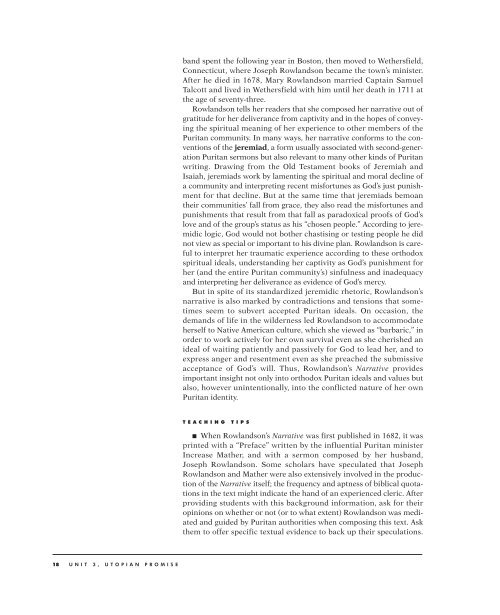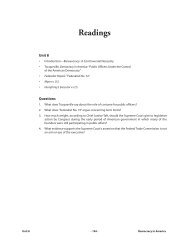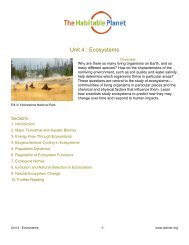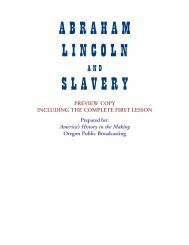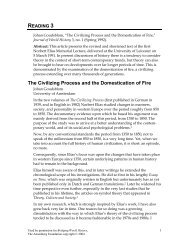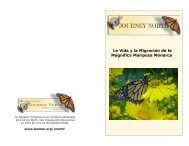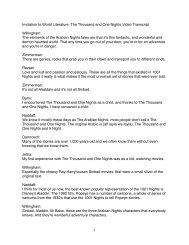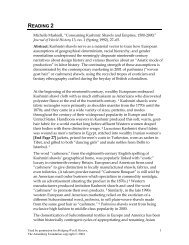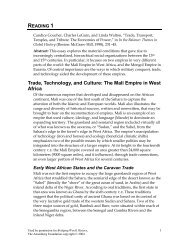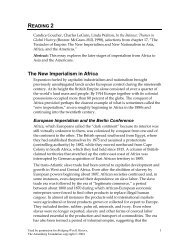UTOPIAN PROMISE - Annenberg Media
UTOPIAN PROMISE - Annenberg Media
UTOPIAN PROMISE - Annenberg Media
Create successful ePaper yourself
Turn your PDF publications into a flip-book with our unique Google optimized e-Paper software.
18 UNIT 3, <strong>UTOPIAN</strong> <strong>PROMISE</strong><br />
band spent the following year in Boston, then moved to Wethersfield,<br />
Connecticut, where Joseph Rowlandson became the town’s minister.<br />
After he died in 1678, Mary Rowlandson married Captain Samuel<br />
Talcott and lived in Wethersfield with him until her death in 1711 at<br />
the age of seventy-three.<br />
Rowlandson tells her readers that she composed her narrative out of<br />
gratitude for her deliverance from captivity and in the hopes of conveying<br />
the spiritual meaning of her experience to other members of the<br />
Puritan community. In many ways, her narrative conforms to the conventions<br />
of the jeremiad, a form usually associated with second-generation<br />
Puritan sermons but also relevant to many other kinds of Puritan<br />
writing. Drawing from the Old Testament books of Jeremiah and<br />
Isaiah, jeremiads work by lamenting the spiritual and moral decline of<br />
a community and interpreting recent misfortunes as God’s just punishment<br />
for that decline. But at the same time that jeremiads bemoan<br />
their communities’ fall from grace, they also read the misfortunes and<br />
punishments that result from that fall as paradoxical proofs of God’s<br />
love and of the group’s status as his “chosen people.” According to jeremidic<br />
logic, God would not bother chastising or testing people he did<br />
not view as special or important to his divine plan. Rowlandson is careful<br />
to interpret her traumatic experience according to these orthodox<br />
spiritual ideals, understanding her captivity as God’s punishment for<br />
her (and the entire Puritan community’s) sinfulness and inadequacy<br />
and interpreting her deliverance as evidence of God’s mercy.<br />
But in spite of its standardized jeremidic rhetoric, Rowlandson’s<br />
narrative is also marked by contradictions and tensions that sometimes<br />
seem to subvert accepted Puritan ideals. On occasion, the<br />
demands of life in the wilderness led Rowlandson to accommodate<br />
herself to Native American culture, which she viewed as “barbaric,” in<br />
order to work actively for her own survival even as she cherished an<br />
ideal of waiting patiently and passively for God to lead her, and to<br />
express anger and resentment even as she preached the submissive<br />
acceptance of God’s will. Thus, Rowlandson’s Narrative provides<br />
important insight not only into orthodox Puritan ideals and values but<br />
also, however unintentionally, into the conflicted nature of her own<br />
Puritan identity.<br />
TEACHING TIPS<br />
■ When Rowlandson’s Narrative was first published in 1682, it was<br />
printed with a “Preface” written by the influential Puritan minister<br />
Increase Mather, and with a sermon composed by her husband,<br />
Joseph Rowlandson. Some scholars have speculated that Joseph<br />
Rowlandson and Mather were also extensively involved in the production<br />
of the Narrative itself; the frequency and aptness of biblical quotations<br />
in the text might indicate the hand of an experienced cleric. After<br />
providing students with this background information, ask for their<br />
opinions on whether or not (or to what extent) Rowlandson was mediated<br />
and guided by Puritan authorities when composing this text. Ask<br />
them to offer specific textual evidence to back up their speculations.


